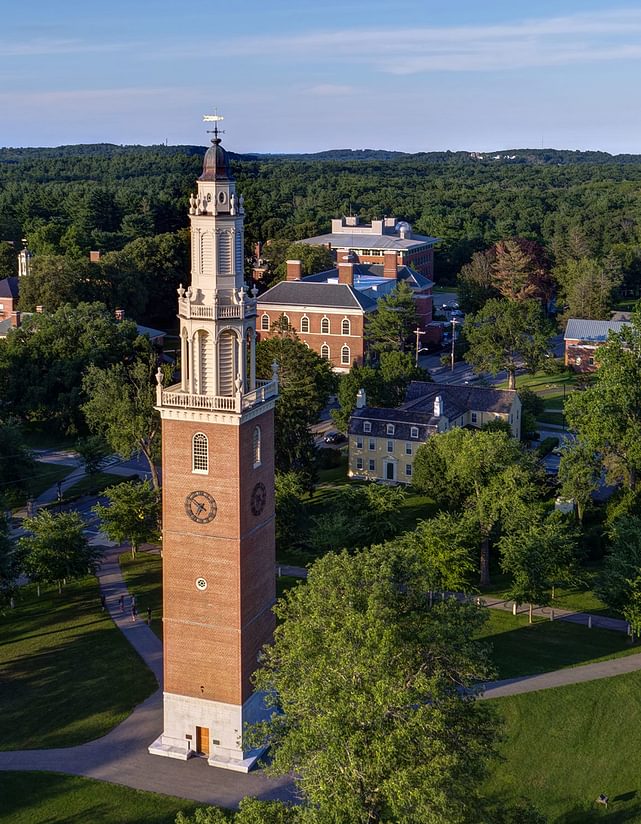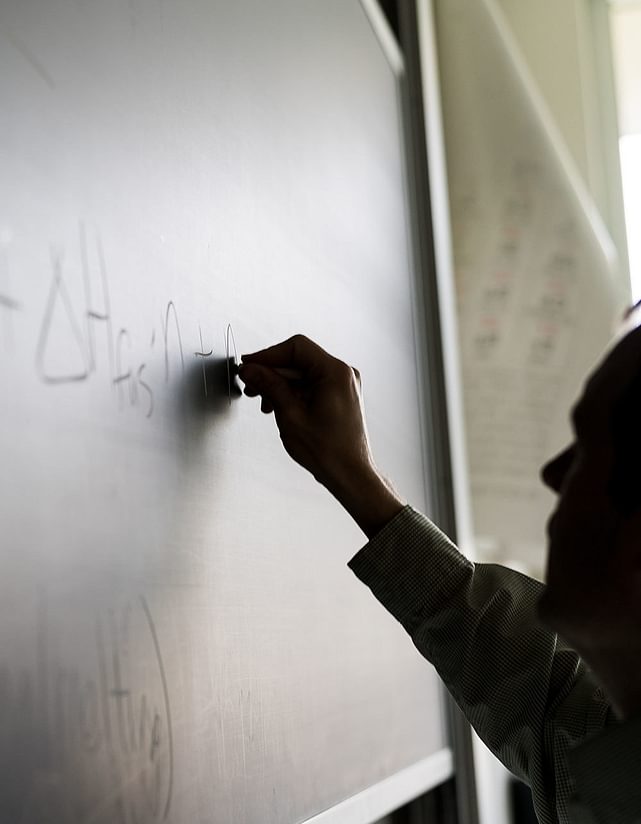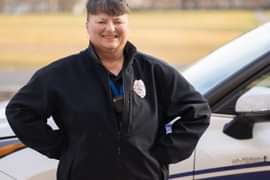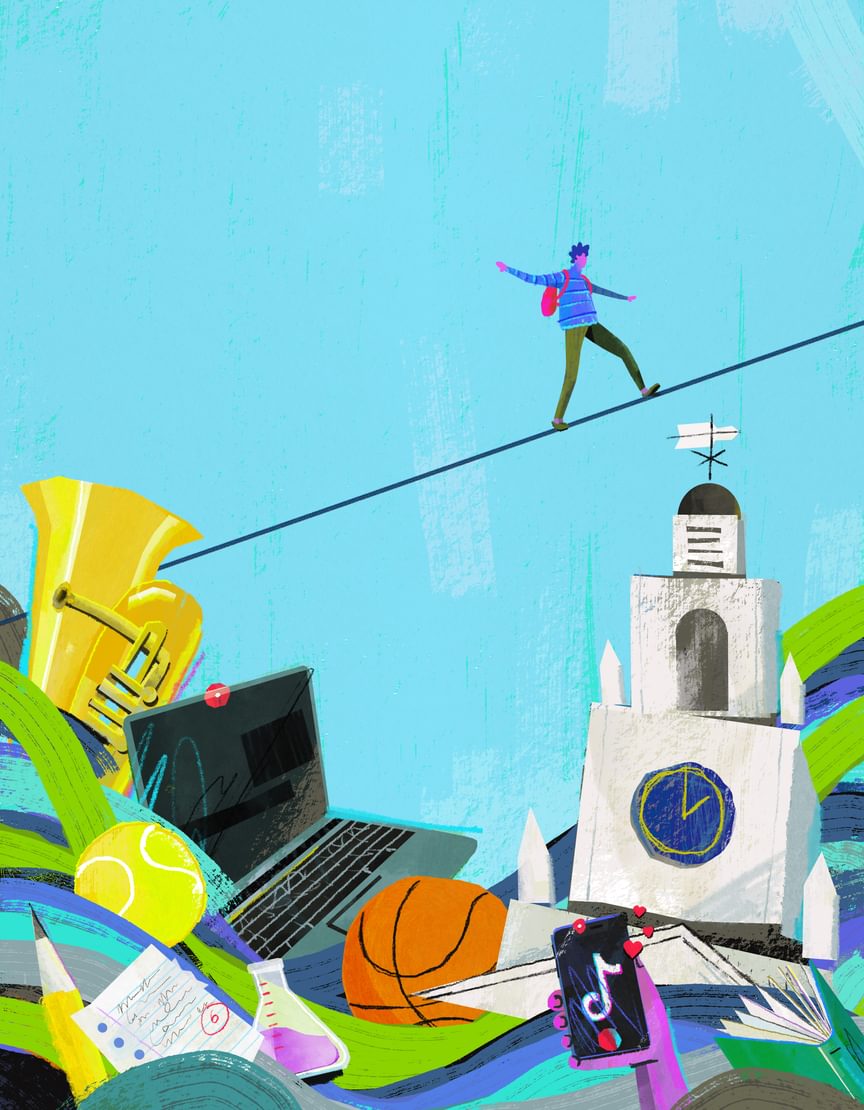
December 15, 2022
Finding balance
How community is changing the conversation on mental healthby Rita Savard
“When I came to Andover, it was a very difficult transition,” recalls Sofia Checchi ’23. “I’m from a big family in Los Angeles. After a year of remote learning, I moved across the country at 16 and started in-person classes.”
It was 2021. A “weird” year, Checchi adds, filled with unpredictability due to the pandemic, political upheaval, and racial reckoning.
“I was struggling. It was hard being 3,000 miles away from my family—we’re extremely close. I felt alone, and it was difficult to talk to people I didn’t know about the anxiety I was feeling.”
Adolescence is hard enough. The pandemic made it harder, adding loneliness, depression, and grief into the mix.
By nearly every metric, student mental health worldwide is worsening. New data from the Centers for Disease Control and the National Center for Education Statistics illuminates our nation’s mental health crisis and its effect on students. Both organizations report a significant increase in the percentage of students seeking mental health services and a steep rise in school staff reporting concerns about students exhibiting symptoms of depression, anxiety, and trauma.
“The pandemic brought into sharp focus mental health issues that for some were just under the surface,” says Head of School Raynard S. Kington, MD, PhD, P’24. “They manifest in a range of ways, such as poor sleep habits, self-harm, and alcohol and drug use. The Sykes Wellness Center has seen a significant increase in mental health visits since 2018. Given what our students have experienced because of the pandemic—isolation and loss, disruption in their education during the most formative years of their lives—I truly believe this generation will push us to fully integrate mental health as an essential component of how we define excellence at Andover.”
To ease the stress students are facing, faculty and administrators are building new pathways for education, awareness, and resources for all stakeholders in the PA community. The focus is on a framework of self-care, peer support, and incorporating a broader culture of wellness into policies, systems, and day-to-day campus life.
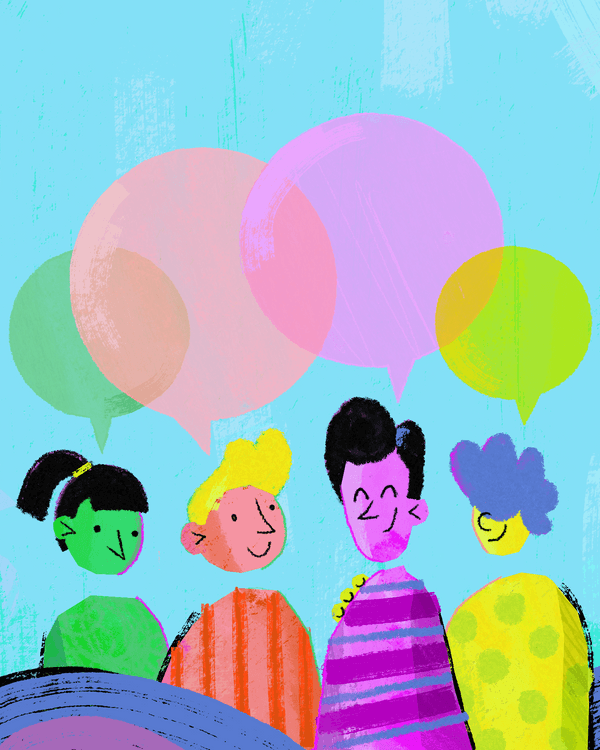
UNDERSTANDING IMPACT
Under constant bombardment from digital impressions, we all sometimes feel like the world is moving too fast. But for Gen Z—the first generation to have grown up wholly in the digital era—this is creating distinct new mental health challenges.
“Before the pandemic, mental health was on our minds,” says Dean of Students and Residential Life Susan Tsao Esty, PhD, P’22, who, along with a team, researched and designed the Academy’s four-year wellness education program called Empathy, Balance, and Inclusion (EBI)—a combination of social-emotional learning, health education, and cultural competency training. “But the pandemic highlighted mental health because of the isolation it forced. Human beings aren’t wired for isolation. We are social creatures by nature.”
Students today are juggling a dizzying array of challenges, from coursework, relationships, and adjustments to campus life to social injustice, mass violence, and personal loss related to COVID-19. They are also constantly assessing what is real and what is not in a virtual world. Social media endlessly opines on everything from politics to climate change to existential crises about meaning, choice, and freedom in life. This information overload on the brain can create intense symptoms of anxiety—including irritability, restlessness, fatigue, sleep problems, an inability to stay calm or control feelings of worry, and difficulty concentrating—as well as physical aches and pains.
Let’s be clear. Adults are feeling their share of anxiety too. But in adolescence, particularly when puberty hits, the young brain becomes hypersensitive to social and hierarchical information. The prefrontal cortex region of the brain that regulates self-control is not yet fully developed—meaning teenagers struggle to process stressors before their brain is mature enough to handle them.
Despite its challenges, Esty points out that adolescence is also a time when the brain is highly capable of developing resilience and healthy coping mechanisms.
In her 10th-grade EBI class, students have candid discussions about growing through challenges, such as managing self-care, and they are learning to connect with and comprehend their own emotions. Seniors can later facilitate conversations with lowers so there is community building and support networking among peers.
“Just this week [October] we discussed social media and our lives on and offline,” Esty says. “Students reflected on questions like, What would you do if you felt this was unhealthy for you?, How would you know?, and What steps would you take?
“Scrolling is addictive, and during Covid our phones and computers were the only option we had for interpersonal contact for too long,” she adds.
Social media certainly has some positive attributes—connecting us with people all around the world, showing us content we’re interested in, and providing entertainment—but there are consequences to endless scrolling that directly impact a person’s emotional state.
Over a career spanning more than two decades in scientific research, Cybele Raver ’82 has investigated how children’s brains process and address threats. Raver, a developmental psychologist currently serving as provost and vice chancellor for academic affairs at Vanderbilt University, also works with various local and federal government agencies to promote healthy development and learning among children.
At Vanderbilt, Raver works across the community to make student mental health and wellness central to the school’s educational mission. Educators, she stresses, can play a unique role in helping students navigate their complex digital lives.
“Digital forms of communication involve multitasking,” Raver says. “You’re focused on so many things simultaneously and your brain is moving from point to point very swiftly, which is great in some respects—it’s really amazing our brains can do that. But it also suggests we aren’t able to be in the present.”
Take something as simple as sending a text. “If you’re texting, it’s unlikely that you’re also processing that there’s a great smell of pie baking in your kitchen and that the light is falling through the window on the flowers on the countertop,” she says. “You’re probably not able to soak in those other sensory details that make life rich and detailed and enjoyable. And particularly that’s true for relationships.
“I think it’s important for our physiologically driven and sensorially driven systems to just come down off of the intensity and speed of digital platforms and to be really focused and purposeful about being in the present.”
Andover educators are guiding students to form healthier relationships with digital technologies. One of EBI’s many touchpoints that support total student health is exploring what it means to grow up digital.
“In-person communication is vital because it leans heavily on using all of our senses,” Esty explains. “We are just starting to get comfortable again with face-to-face connection and there’s no shortcut to healing—no timeline has been published anywhere to indicate how long it takes to reset after a global pandemic. But to feel heard is powerful. With every small dose of, ‘Oh, I just did this thing for two hours with my friends and I wasn’t on my phone, and it was really fun,’ we are in the present and moving toward healthy habits.”
Sofia Checchi is candid about the fear of being singled out as “less than” in Andover’s sea of academic superstars. A combination of anxieties from loneliness to imposter syndrome—common at high-achieving schools like Andover—held her back from taking those first steps to talking openly about her feelings.
But wellness outreach is growing deep roots at the Academy, with adults empowering students by encouraging active roles in supporting one another. Modeled after the faculty and staff Wellness Collaborative, the Student Wellness Collaborative comprises leaders of clubs such as Students in Medicine, the Sykes Medical Initiative, Active Minds, Peer Listeners, YES+, and HOSA (future health professionals). All meet with faculty and staff to spend more time checking in on students’ mental health needs and school readiness.
“Allowing yourself to be vulnerable is scary,” says Checchi, who now volunteers as a peer listener, helping other students get through tough transitions and befriending those in need. “But vulnerability is also a place of great strength. Once I built up the courage to start talking about the pressure I was under, I was able to start managing it—and I saw that I wasn’t alone.”
We have to think of this as a public health issue and treat it appropriately, because the research shows that when a school has a system-based, evidence-based, whole school–approach, all students benefit.
”CREATING A CULTURE OF WELLNESS
There are many students like Checchi who, with PA’s support systems in action, become more empowered to find balance in their daily lives. But all eyes at Andover are fixed on the data, which shows schools nationwide facing a surge in demand for care that far outpaces capacity.
Within the past decade, teen suicide rates have surged 40 percent and one in five high school students report that they have considered suicide. In December 2021, these numbers entered the national conversation when U.S. Surgeon General Dr. Vivek Murthy released a 53-page report warning that young people across racial, economic, and gender lines are facing a “devastating” mental health crisis because of the challenges experienced by their generation, including the coronavirus pandemic.
The bottom line, says Vivian Báez, interim director of psychological services and a counselor at the Rebecca M. Sykes Wellness Center, is that teaching today must be synchronous with addressing mental health.
“We have to think of this as a public health issue and treat it appropriately, because the research shows that when a school has a system-based, evidence-based, whole school–approach, all students benefit,” Báez explains.
Báez, Chief Medical Officer Dr. Amy Patel P’26, and Associate Head of School for Equity, Inclusion, and Wellness Linda Carter Griffith are working to restructure a mental health and wellness model that historically has relied on weekly one-on-one counseling.
“We are building systems to strengthen support and resources that are more consistent with meeting the needs of all students in a variety of ways,” Patel says. “School connectedness—a student’s belief that they have adults in their school community who support, value, and care about their well-being—is an important protective factor for all adolescents. Every adult on campus, in partnership with parents and guardians, plays an integral role in fostering these important relationships.”
Patel and Báez stress that today’s student wellness initiatives are not just about focusing on crisis management. It’s a holistic approach that pays just as close attention to early identification, prevention, and routine care.
Big Blue Be Well, established in spring 2020, connects students directly to student-centered educational programming. The initiative is focused around six core principles of health: nurturing relationships with others and community, stress management, movement and exercise, nutrition, sleep, and healthy relationships with substances.
Because demand for services has increased on and off campus, the Sykes Wellness Center team is also expanding its delivery model to include mental health first-aid training for all faculty, more group workshops for students, and telehealth counseling services that can be accessed even when a student is away from the Academy.
“This is about meeting students where they are at now,” Báez explains. “Part of that is navigating when it’s beneficial for students to use online and digital technologies and when it’s beneficial for students to be seen in person.
“Interpersonal energy is deeply nourishing,” Báez reminds, “but we have to keep in mind that the needs of students are different. Some may feel that telehealth is more accessible and less intimidating. In that sense, virtual options have truly opened doors for reaching more people—it’s why so many colleges and universities are deploying the technology as another layer of services.”
Behavioral health screenings, an “evidence-based tried-and-true tool,” says Patel, are another key component in the Academy’s data-driven approach for support.
Even when a student comes to the wellness center with something as simple as a common cold, they complete a behavioral health screening that assesses for conditions such as depression, anxiety, and/or substance abuse disorder.
“Mental health screening is a proactive approach to gathering valuable information for planning and implementing prevention and early intervention strategies before problems develop or worsen,” Patel explains.
In February, the Academy will be administering the Independent School Health Check survey to all students. The goal of this anonymous survey is to open conversations about how kids are feeling emotionally and to connect them to help before issues escalate.
The data can also be helpful in highlighting strengths and concerns specific to certain subsets of a school’s population, such as a single grade or group. Understanding these possible trends can be critical for providing equitable support systems.
“This is another window into assessing students’ mental health needs,” Báez adds. “We can’t wait until a crisis. Like diabetes or heart disease, you don’t want to wait until it’s progressed before you intervene.”
No one is perfect, and you have to be kind to yourself, especially when you’re going through a lot. Trust that you have the ability to do what you need to do.
”
CHANGING THE CONVERSATION
Mental health disorders are prevalent, yet there are often feelings of embarrassment and shame and a desire for secrecy when an individual is struggling. The best way to reduce stigma, says Nicole Jeter, director of wellness and prevention education at PA, is to talk about it.
“When students tell each other their stories, they can better see the reality of how many people are going through similar experiences,” Jeter says.
This idea was the foundation for the Peer Listening Program that started taking shape in 2020. Seniors in leadership roles volunteered to become wellness mentors and talk with other students about topics like homesickness, how they’re adjusting to Andover, if they’re eating well, and how they’re spending most of their time.
Peer listeners are not professional counselors but are trained in active listening, problem-solving, crisis response, and stress reduction. Their mission is to foster emotional well-being through peer-to-peer support, which happens through individual meetings and small group gatherings.
Logan Suryamega ’23 remembers having his first anxiety attack during spring of upper year.
“Looking back, it’s still scary,” confides Suryamega, now a peer listener. “What got me through that period was really leaning into what I love and who I love. Playing volleyball is something I love—it helps me destress.”
Suryamega also opened up to some friends, who recognized he was struggling and validated him, and to a teacher who shared his passion for volleyball. The connections helped anchor him during a difficult time.
“Most important, I think, is to give yourself grace,” Suryamega tells his peers. “No one is perfect, and you have to be kind to yourself, especially when you’re going through a lot. Trust that you have the ability to do what you need to do. And when you feel like you’re not strong enough, know you don’t have to go through it alone—I’m here for you. We’re all here for you.”
Shani Evans ’92 understands the struggle. You might say the editorial nail artist is having a moment. This past summer in East Harlem, New York, she became the face of mental health and wellness—literally. Evans’s larger-than-life image was featured on a seven-story mural adorning the Ascendant Heritage Building on the corner of 104th and Madison Avenue. The design, by artist Kristy McCarthy (also known as D. Gale), employs visual metaphors and symbols to illustrate the pain and difficulty of living with a mental health condition while also encouraging mental health awareness.
Evans, who attended PA for three years and later Wellesley College, is a mother and a teacher who has carved out a name for herself as an established artist and an entrepreneur. She has also learned to live her best life with bipolar disorder.
“I thrived academically in so many ways, but there were already symptoms of my brain chemistry starting to manifest at 15,” Evans says. “My first, near-catastrophic depression happened while I was at Andover. It’s like living with an uninvited guest that you learn to make friends with. They’re not going anywhere. So you learn to live together and meet in the middle.”
New York’s Department of Health sponsors the NYC Mural Arts Project to destigmatize mental illness by making it visible in communities and sparking conversation around it. Since launching in 2016, the program has created 10 large-scale murals and two mural benches.
“Art is a way to get the community talking about mental health,” Evans says. “No person, no family goes untouched. It’s another way of telling the community that mental health is not a mark of being defective. It’s a mark of being alive. And we need to check in with each other. Community helps hold you together.”
IT’S OK TO BE NOT OK
When it comes to stemming the tide of rising mental health challenges, there is no quick or easy fix. But mindful schools can help transform their community from the inside out. And from the Sykes Wellness team to student leaders to faculty, staff, and administrators—all working together—the road to recovery can lead somewhere new. A place of transformation that is more flexible, resilient, more individualized and equitable, and, most of all, more joyful.
“When everyone in the community is working together,” says peer listener Erin Kim ’23, “even small changes can tackle big problems.”
At Vanderbilt, Raver says a colleague who heads athletics views mental health as “supporting peak performance.” The women’s soccer team, for example, spends 90 minutes on the field, but they have a three-and-a-half-hour period that is devoted to a holistic approach, reviewing mental health and wellness.
“Mental health and personal self-care are part of how you train for peak performance,” Raver says. “This is a wonderful way to look at education. We’re training the next generation of community and world leaders, and we’re teaching them that mental health is an integral part of how they prepare for performing at the absolute best level.”
Thought leaders from the Academy are also sharing valuable insights and resources by helping peer schools strengthen systems of support and open a dialogue around mental health and wellness.
At the Association of Independent Schools in New England’s annual diversity, equity, and inclusion conference in October, Patel led a session about deconstructing imposter syndrome; Laura Warner, director of the Academic Skills Center, discussed building a sense of belonging among students with neurodivergent profiles; and Deb Olander, instructor in mathematics, statistics, and computer science, presented on anti-racist education and moving beyond performative allyship.
As academic institutions worldwide explore ways to make mental health and wellness front and center of their curriculums, Head of School Raynard Kington stresses the importance of tackling these challenges as a team—and every member of the community is vital to a school’s success.
“Extending this mindset to the classroom, where students often feel the most pressure to perform, will only enhance their experience,” Kington says. “Andover’s extraordinary resources and rigorous academic program matter very little if the students in our care are not healthy in body and mind and learning to manage the pressures that are so palpable for adolescents today.”
Student peer listeners agree. Checchi, Suryamega, and Kim have weathered their own sets of challenges at Andover. They want all students to know: “You are enough, no matter what.”
And they’re ready to be someone their peers can talk to. Anytime.
“I really just want other students to see me as an older sibling or a friend who they can feel connected to and feel comfortable approaching,” Kim says. “Whether you had a bad day or got a 6 on your math test and want to celebrate, you have friends at Andover—whenever you need us.”
